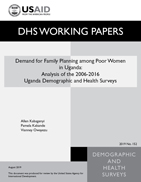
Abstract:
Background: Family planning is one of the
major cost-effective interventions to improve
maternal health, reduce maternal and child
mortality, and prevent unplanned pregnancies,
yet its use remains low in sub-Saharan
Africa, especially among the poor. In Uganda,
little is known about the factors influencing
the demand for family planning among the
poor. This study examines the determinants of
demand for family planning among poor women
in a limited-resource setting.
Methods: The study is based on data from the
2006, 2011, and 2016 Uganda Demographic and
Health Surveys (UDHS). Multilevel binary
logistic regressions were used to examine the
influence of different demographic,
behavioral, and socioeconomic factors on poor
women’s demand for family planning.
Results: Our findings showed demand for
family planning was 56% in 2006, 60% in 2011,
and 65% in 2016 among women in the poorest
and poorer household health quintiles who
were married or in union. In all three
surveys, women age 25-39 had higher odds of
demand for family planning compared with
women age 15-24. Women with no education had
lower odds of demand for family planning
compared with those with secondary education.
Also, in the 2011 UDHS, women who had heard
about family planning on the radio had higher
odds of demand for family planning compared
with those who had not, and in the 2006
survey women who had discussed family
planning at a health facility had higher odds
of demand for family planning compared with
women who had not done so.
Conclusions: Demand for family planning is
influenced by a woman’s age, educational
attainment, religion, exposure to family
planning messages on the radio, and
discussion on family planning at a health
facility. This study underscores the need for
increased family planning counseling by
health workers and more discussion about
family planning at the health facility. The
findings further suggest the need to provide
increased adequate family planning services
and information for the poor, uneducated, and
rural women to meet the demand for family
planning.
 Demand for Family Planning among Poor Women in Uganda: Further Analysis of the Demographic and Health Surveys (PDF, 596K)
Demand for Family Planning among Poor Women in Uganda: Further Analysis of the Demographic and Health Surveys (PDF, 596K)
